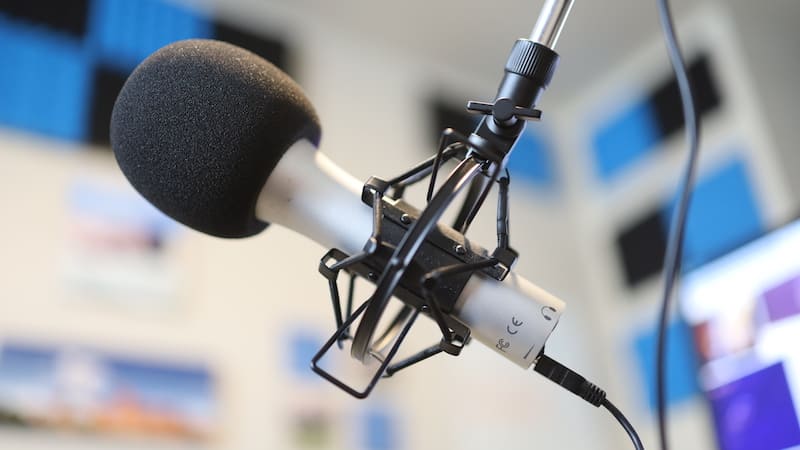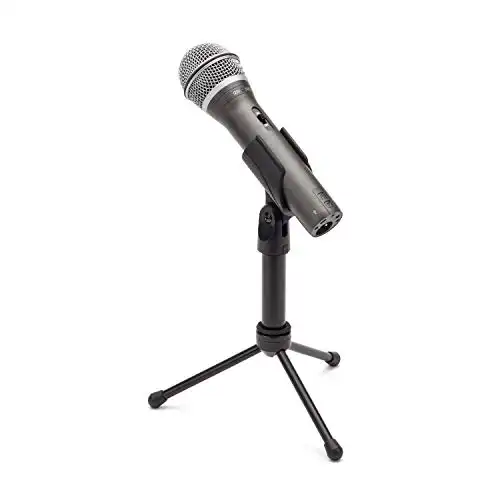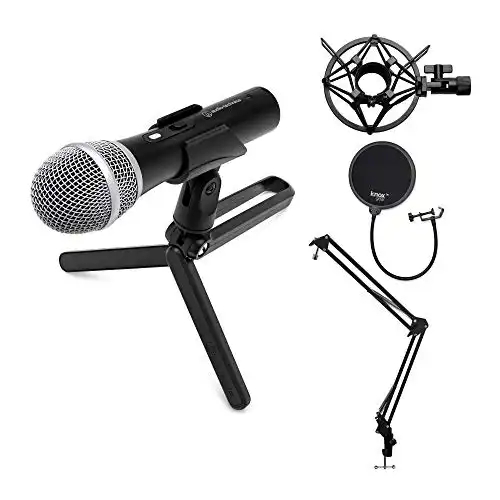You’re looking to buy a microphone. You’ve already spent hours scouring the reviews and forums to figure out which one is the best. It’s taken you so long, but you managed to narrow it down to the Samson Q2U and the Audio-Technica
The problem now is which one do you buy? Never fear! We’ve compiled all of the details of both microphones for you. All you have to do is read it, choose one, and record some of that creative content!

Table of Contents
Samson Q2U
The first microphone is the dynamic Samson Q2U. Primarily, this mic is designed to reduce any background noise and is perfect to use in a room that isn’t sound-treated.
This product was first available in 2004, and even 16 years later, it’s stood the test of time. It’s a handheld mic, so it’s good to use both on stage and on the move if you’re, for example, doing interviews outside or going to crowded places such as conventions. If you don’t plan on moving around too much, you can mount it and put it on your desk.
Audio-Technica ATR2100
Another dynamic microphone, the
For a beginner mic, the 2100x is relatively cheap, produces professional sound quality with other attractive features. Honestly, it’s a fantastic mic even for pros and audio connoisseurs.
How different are they?
You may find people talking about how these two microphones are essentially the same product and that it doesn’t matter which one you choose. Still, there are some differences between the two models. Let’s take a look at them.
The kits
The Samson Q2U kit is a podcast pack. It is said to have everything that a beginner needs to start recording. Along with the microphone, you get an extendable desktop stand, a mic clip, a pop filter that reduces those pesky plosives, and the USB and XLR cables.
The
Although the kit contains all the necessary equipment, it can feel cheap and may not be good enough for podcasting. Instead, purchasing additional equipment separately for better recording performance is better.
The microphone build
While both microphones sport a similar design with slight color variations, the
The volume can be modified on both of the microphones. Samson Q2U has up-down buttons; the
The sound
The Samson Q2U has a more robust sound quality, efficiently decreasing background noise while making your voice fuller and more professional.
While the ATR2100 sometimes tends to sound more muffled, it does record less of the pops that are more likely to show up in a Q2U recording (which might be why that kit comes with a pop filter), along with less background detail. When on the same audio level, the Samson seems louder and more sensitive than the
How similar are they?
Immensely similar.
- They are both currently rated well on Amazon, so there is no help there in deciding which one to buy.
- They both have a USB and an XLR output. The USB output means connecting both microphones directly to the computer and instantly recording in your chosen software. The XLR output means you can plug the microphone into a mixer or other additional equipment to improve the sound.
- As mentioned, they are both dynamic microphones, and as such, they only pick up loud noises. Meaning that a lot of the background noise a lot of people have to deal with is decreased.
- The cardioid or unilateral pick-up pattern means that the microphones pick up sound from the front and not from the sides or the back, again adding to the reduction of unnecessary noise.
- Both have a built-in 3.5mm headphone jack, which allows you to listen to your audio latency-free, which is excellent as you can check the quality of your recording in real time without delay.
- Both are plug-and-play. All the necessary drivers automatically download, so you don’t have to bother with any more tech.
- Both microphones work well on the PC and the Mac, so whichever operating system of the two you may use, you won’t run into any problems.
- They are both handheld microphones, so you can easily use them on the go.
- They are both in the lower price range, making it affordable for beginners and those still unsure if they want to commit more money and energy to do a podcast.
Pros and Cons of Samson Q2U
Pros
The first central point for the Samson Q2U is the XLR/USB output availability. As a beginner who may be on a tight budget, the USB connector allows you to record your audio without additional equipment. However, if you decide to upgrade the sound quality, you won’t have to worry about buying a new mic; you’ll be able to use this one.
Compared to condenser microphones, this dynamic mic is ideal for those who do not have treated rooms or studios, as it will filter out all of the background noise. And again, if you are traveling and still want to continue recording? It’s still perfect for you.
The sound quality is very good for the price, as this mic is in the cheaper range. The audio is good enough to post without additional editing (though it is advised to do some post-production to ensure the quality of the final product).
Cons
This mic has several problems that have been reported multiple times. If you leave the USB connected to your computer just turned off, when you switch it back on, the mic will only produce static. It will not work until you pull it out and plug it back in again. While this may not seem like more than just an annoyance, the constant unplugging will wear down the cable and the already finicky USB port, which is another reported issue.
Another issue, despite this microphone being labeled as a handheld, is that it’s pretty heavy. Therefore, holding it for extended periods may be exhausting. As such, it can’t be that useful unless it’s mounted and on a desk.
Another issue is that while the top of the microphone reduces noise when they come from the sides or behind, the body isn’t built to decrease noise as efficiently when it makes contact with something. And to hold a microphone, your hand needs to come in contact with it.
Pros and Cons of ATR2100
Pros
Another microphone with dual XLR/USB output, making it a fitting choice for a podcast beginner, much like the Q2U. The XLR output is also a great mic to transition from a beginner to a more experienced podcaster. It is lighter, so it can be used on the go, outside, and on stage.
It even has a foldable mic stand you can bring if you find a surface to put it down on. There’s an on/off switch on the microphone itself, which can be useful for muting if you don’t want to click around your recording software.
It is excellent at nullifying background noise as a single microphone, and the plosives don’t pop as much. It works great in big crowds, such as you might get on the street or at conventions.
It is affordable, has a good quality sound, and build for its price. It’s easy to set up, making it perfect for when you travel and cannot pack much, and you only need to bring a laptop. It has a lifetime warranty, which is phenomenal. You don’t have to worry about getting a new microphone the instant this one starts having problems.
Cons
The audio records a bit too quietly, so you need to be very close to it, and even then, sometimes, it’s still not loud enough. Quiet audio can be fixed by increasing the gain; however, that comes with the problem of additional fuzziness.
Editing, while more effort, is a simple solution to that problem. The USB port may experience a malfunction, as it doesn’t seem to be the highest quality. The headphone jack may also encounter issues, and you may need to wiggle your cables to get the audio to filter through properly. While the tripod is portable, its height is not adjustable. It is also said to be of a lower-quality build.
User experience
Audio Technica AT2100 and Samson Q2U are both popular microphones among users. However, some find that AT-2100 sounds slightly thinner while Q2U is deeper and denser. The overall quality is perceived to be the same.
According to users, both microphones sound relatively similar, although the AT2100 is quieter and might require you to raise the volume more on it if you choose to.
The Samson Q2U, on the other hand, produces a louder sound and doesn’t require as much pre-amp to work with. Still, it is possible to encounter white noise when using Samson Q2U, especially when increasing the volume to the max. Given that they both have their flaws, it is crucial to try out both models to see which suits your needs better.
So, which microphone do you buy in the end?
Well, it depends on your needs. Get yourself the Samson Q2U if you are looking to start podcasting and are eager to record but do not want to put too much effort into editing. The audio output will be almost perfect even without post-production.
Buy the Audio-Technica ATR2100 if you want to start podcasting, but you know you will be on the move more; this is the mic for you. Easily portable with excellent noise reduction, you’ll be able to record anything and everything you encounter while on your feet.
With that said, these products are similar enough that you won’t regret buying either one.
Further Reading
Samson and Audio Technica

